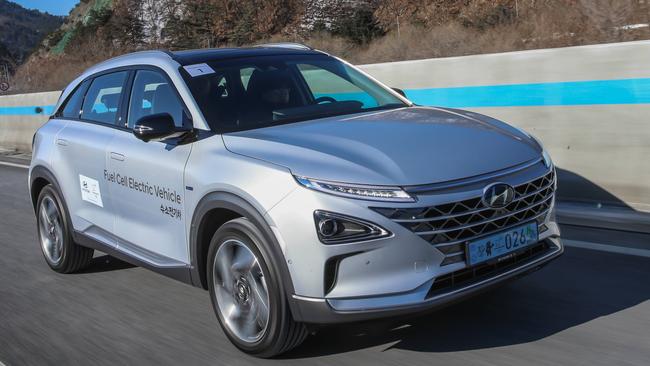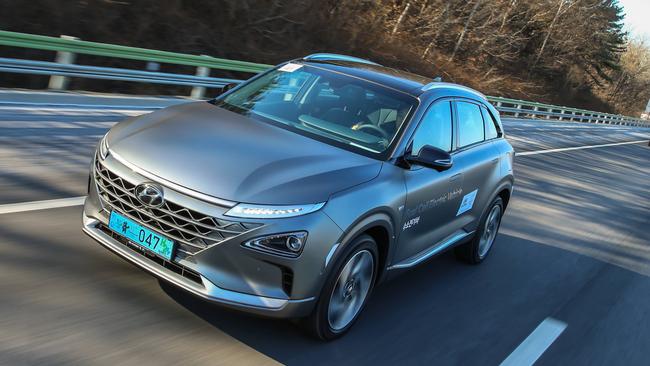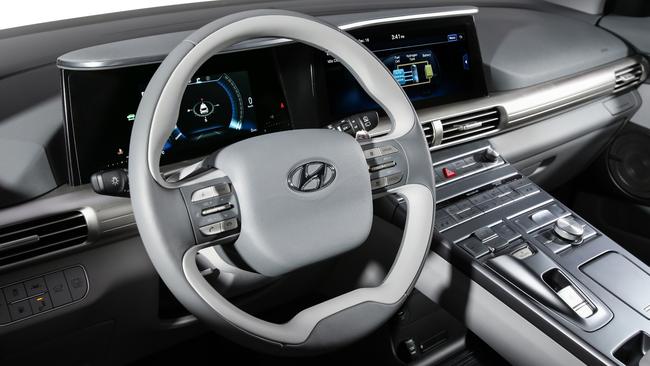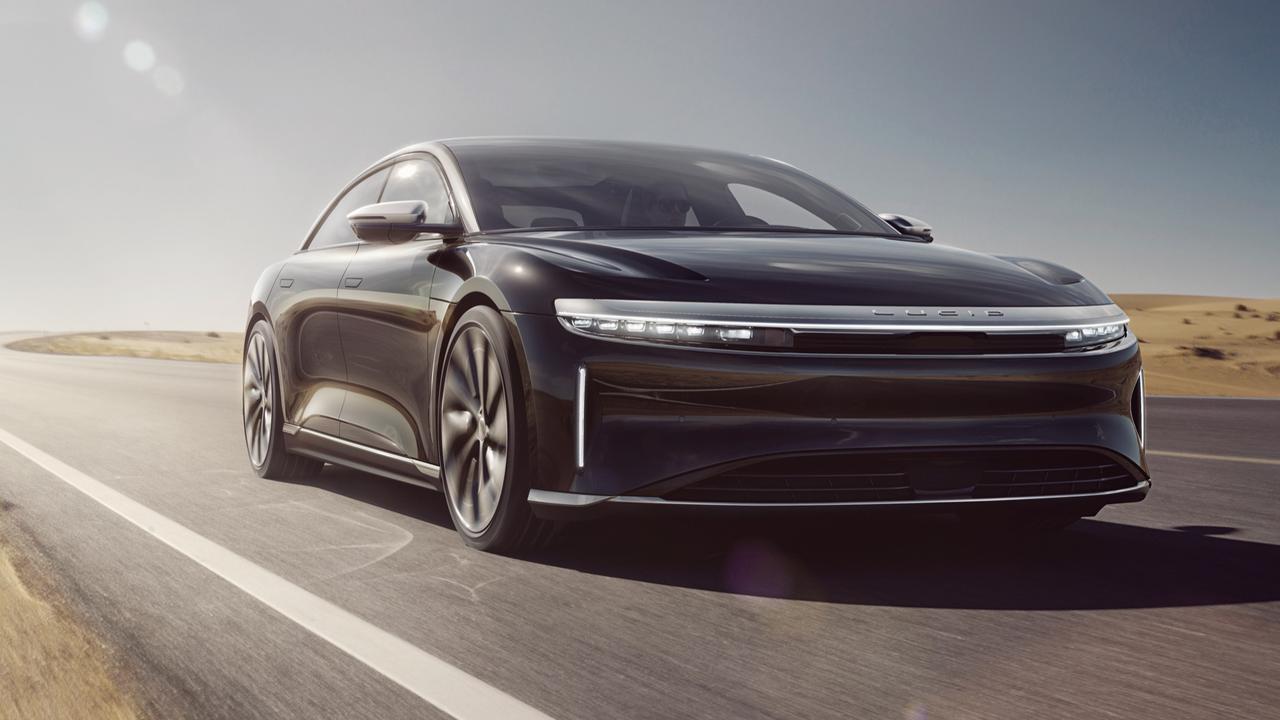Hyundai Nexo hydrogen car faces a not-so-soft cell
Hyundai’s Nexo SUV is a standout performer. It runs on hydrogen, emits only water, runs as quietly as any battery powered vehicle — and drives just like a regular car.
The Winter Olympics are famous for astonishing performances from athletes who aren’t as high-profile as their mainstream counterparts. That makes PyeongChang in South Korea the ideal environment for Hyundai to launch its Nexo hydrogen fuel-cell SUV.
Hydrogen-powered vehicles make battery electric cars look like bestsellers, largely because developing and setting up hydrogen fuelling sites is far harder than setting up electric charge stations.
That’s not likely to change in the short term — even Hyundai says only two of the 38 “eco-friendly” vehicles it plans to have on the road by 2025 will be powered by fuel cells.

The Nexo is a standout performer thanks to a range of firsts, from the 60 per cent efficiency of the fuel cell stack (a typical combustion engine is about half as efficient) to the use of three hydrogen tanks to ensure the Santa Fe-sized SUV has a Santa Fe-sized cargo area.
The real appeal for potential buyers is the fact the Nexo drives just like a regular car. Acceleration is on par with a large SUV and the experience from behind the wheel is virtually identical, apart from the fact the Nexo runs as quietly as any battery powered car.
Where the Nexo steps up is its range — 600km, based on tests following the South Korean standard, which is more realistic than the 800km achieved in the European test cycle.
A 250km test drive in South Korea this week shows such a range is probably achievable in highway driving. That takes range anxiety out of the picture.

It also takes just five minutes to refuel — providing you can find a hydrogen station. There’s only one permanent set-up in Australia, at Hyundai’s head office in Sydney.
That’s part of the Nexo mission — to convince governments and the public that zero-emission fuel cell vehicles are a viable part of our future transport mix.
The Nexo is effectively pioneering hydrogen cars in Australia. The ACT Government is due to take 20 examples early next year, making them the first hydrogen fuel-cell passenger cars to be sold here … but not the last.
Hyundai manager of future mobility and government relations Scott Nargar says we’re about a decade behind the US and Europe in adopting alternative fuels, whether hydrogen or electricity. He says smaller cars are better suited to battery power — but larger vehicles doing longer distances, such as SUVs, buses and trucks are more economical when hydrogen powered.
ON THE ROAD
Autonomous emergency braking can be found on $20,000 cars so it’s no big deal to find it on the Nexo. However, the quality of the car’s lane-keep assist is — much like the running gear — next generation. You won’t find better this side of a Mercedes-Benz E-Class, even if the Hyundai can’t change lanes without human direction.
The ride and handling is exactly what you’d expect from a Hyundai SUV, compliant and direct. It accelerates like any large family SUV — Hyundai claims 9.2 seconds for the run from rest to 100km/h.

Three 52L tanks store about 6kg of hydrogen. At current prices that’s comparable to filling up a car with petrol, or about $70. Unlike petrol, costs will drop as more vehicles hit the road and economies of scale improve.
The brake pedal suffers from the same vague feeling as any electric vehicle because it is linked to the car’s battery to help recover power when decelerating.
A tunnel between the front seats accommodates the buttons controlling the infotainment, aircon and gear selection. It looks cluttered compared to the minimalist approach of contemporary internal combustion cars but is straightforward once you work out where the switches are.
What lets the Nexo down, given its predicted $80,000-$85,000 price, is the quality of the interior plastics. The contact surfaces are soft-touch; those below the sight line are still more at home on a $45,000 SUV.
That’s the price you pay for being an early adopter and it applies equally to such battery vehicles as the BMW i3.
HYUNDAI NEXO
PRICE $85,000 (est)
WARRANTY 5 years/unlimited km
SAFETY 5 stars, 6 airbags, AEB
MOTOR 120kW/395Nm
TRANSMISSION Direct drive; FWD
RANGE 600km (Korea standard)
0-100KM/H 9.2 seconds
HYDROGEN HITS THE ROAD
To date only Toyota’s Mirai fuel cell vehicle has sold decent numbers. It went on sale in 2015 and global sales hit 5400 by the end of the last year — but only after the Japanese company co-invested in hydrogen refuelling stations to help make the alternative fuel a viable choice for fleet managers and private buyers.

California is the poster child for zero-emission vehicles and the US state accounts for almost half of all global fuel-cell sales, largely due to the fact it has 31 operating recharging stations, another 34 under development and has mandated to have 100 sites open by 2020.
The Mirai accounts for about 80 per cent of US sales of fuel-cell cars but has about 80km less range than the Hyundai Nexo and is styled as a conventional sedan rather than an increasingly popular SUV. Hyundai says the body style and 600km range should give it a packaging and practical advantage. The sales will tell.
HOW IT WORKS
Hydrogen fuel cell vehicles generate electricity by combining oxygen extracted from the air with compressed hydrogen stored in tanks to create a flow of electrons. The only tailpipe emission is water.
Because it literally takes a second for the chemical reaction to occur, fuel cells also use a battery pack — in the Nexo’s case a 33kWh job — to supplement the fuel cell on takeoff and under hard acceleration. Hyundai says the Nexo’s fuel stack has about double the durability of its predecessor, the Tucson FCEV, and backs the technology with a 10 year/160,000km warranty. Once the platinum membrane has lost peak efficiency, it can be recycled.



